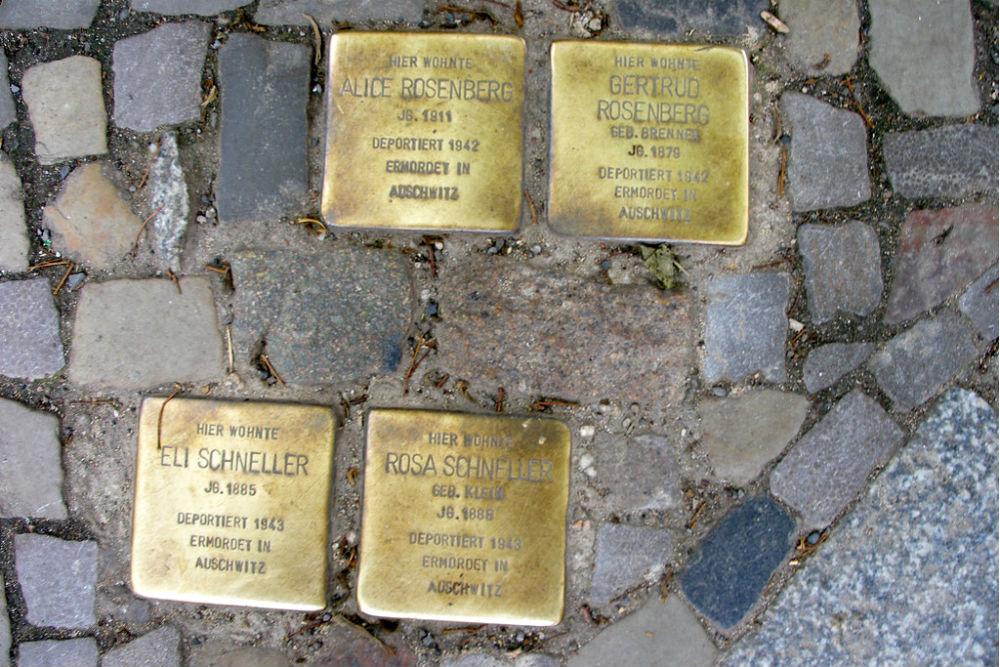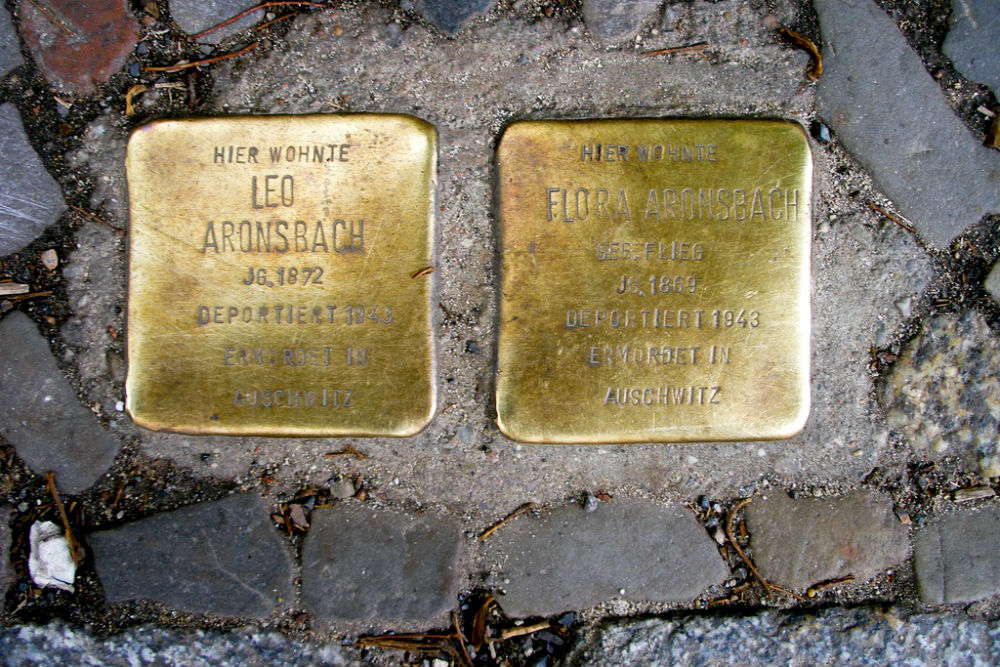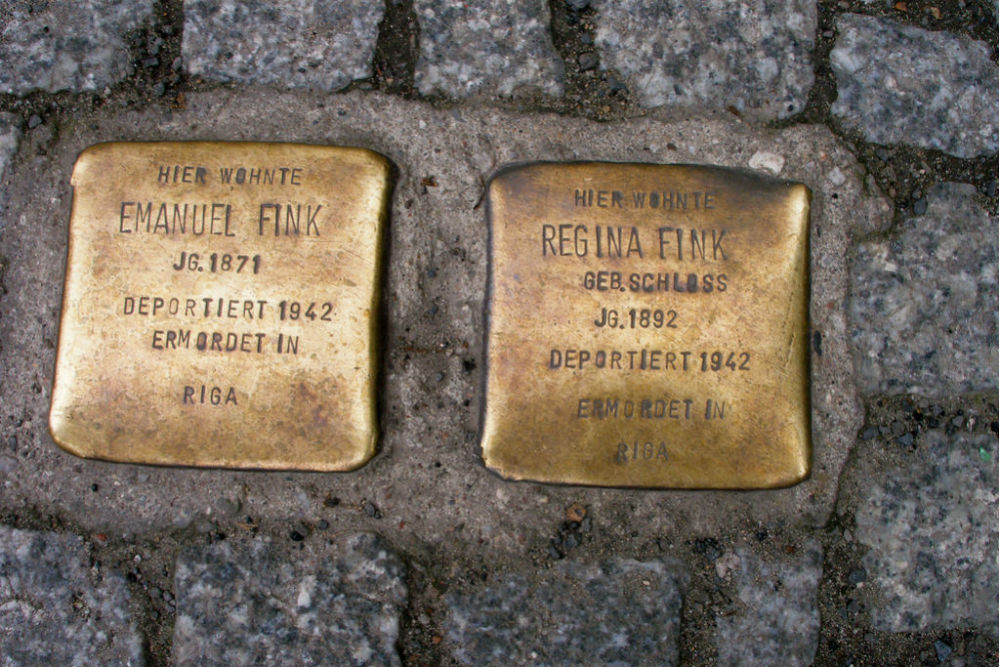Stumbling Stones Große Hamburger Straße 29
These small, brass memorial plaques (Stolpersteine or stumbling stones) commemorate:
* Alice Rosenberg, born 1911, deported 1942, murdered in Auschwitz.
* Gertrud Rosenberg née Brenner, born 1879, deported 1942, murdered in Auschwitz.
* Eli Schneller, born 1885, deported 1943, murdered in Auschwitz.
* Rosa Schneller née Klein, born 1888, deported 1943, murdered in Auschwitz.
* Leo Aronsbach, born 1872, deported 1943, murdered in Auschwitz.
* Flora Aronsbach née Flieg, born 1869, deported 1943, murdered in Auschwitz.
* Emanuel Fink, born 1871, deported 1942, murdered in Riga.
* Regina Fink née Schloss, born 1892, deported 1942, murdered in Riga.
Rosenberg family. Alice Rosenberg was the oldest child of Gertrud and Arthur Rosenberg. She had two younger brothers, Ludwig Lutz (1913) and Heinz (1917). The family moved to a four-room apartment at Großen Hamburger Straße 29. Alice worked as a secretary/stenographer; Gertrude was a housewife, and Arthur was a merchant. After Arthur Rosenberg died in 1937, the family’s financial situation became increasingly difficult, and the the next year, they moved to a two-room apartment. First Heinz, then Lutz emigrated to Palestine. Gertrud and Alice shared one room and rented out the other. Alice and her mother Gertrud were deported together on 9 December 1942 to Auschwitz. The dates of their deaths are unknown.
Schneller family. Eli Schneller, an entrepreneur, married Rosa Klein, an accountant. They had two children, Max and Charlotte, whom they sent in 1939 via Kindertransport to Britain. Rosa was busy in the household of Dr. Lippmann Dossmar before her deportation. Eli and his non-Jewish partner ran a business together until the Nazis’ "Aryanization" rules forced him to give his share to his partner. Eli volunteered for the Reich Association of Jews in Germany. Then on 9 March 1943, Rosa, Eli, and other members of the Association were arrested. Both Eli and Rosa Schneller were deported 3 days later on the 36th Osttransport to Auschwitz and were probably murdered shortly after arrival.
No information was found on the lives of Leo and Flora Aronsbach other than that he was a master bookbinder. They were deported together on I/90, the 90th of 123 transports from Berlin to Theresienstadt: they and around 1,300 Jewish deportees were brought to the train station by truck in the morning of 17 March 1943, and they had to wait until all were registered and counted before the train left that evening. It arrived the next morning. The deportees, most from Berlin, ranged in age from 1 month to 92 years. Only 170 of them are known to have survived. Flora lived another 2 months; her body was cremated in Theresienstadt on 17 May 1943. Leo survived another year at Theresienstadt before he was deported onward to Auschwitz on 16 May 1944 on transport Ea with 2,500 deportees. Unusually, all were shaved, tatooed, and placed into a "Family Camp" at Birkenau. Some were then sent to forced labor elsewhere. This "Family Camp" was designed to assuage fears of persons still at Theresienstadt and to appease the Red Cross and other international delegations. However, in the end, all remaining "residents" of the Family camp were murdered on 10 July 1944. Only 40 from transport Ea are known to have survived. Leo Aronsbach’s date of death is not known.
Fink family. Little information was found on the lives of Emanuel and Regina Fink. He was a textile agent (textilvergreter); they were married, but information on children, if any, was not seen. Their final days are sadly documented. They were deported together, leaving Berlin on transport 18, train Da 401, on 15 August 1942. Over 1,000 persons were crowded into third-class passenger cars for the trip to a destination unknown to them. Soon after their arrival in Riga on the 18th, all were taken and shot in the forests in Rumbula or Bikernieki. There are reports of only one survivor. The dates of the murders of Emanuel Fink and Regina Fink are given by the German Federal Archives as 18 August 1942.
"Stolpersteine" is an art project for Europe by Gunter Demnig to commemorate victims of National Socialism (Nazism). Stolpersteine (stumbling stones) are small, 10x10cm brass plaques placed in the pavement in front of the last voluntary residence of (mostly Jewish) victims who were murdered by the Nazis. Each plaque is engraved with the victim’s name, date of birth, and place (mostly a concentration camp) and date of death. By doing this, Gunter Demnig gives an individual memorial to each victim. One stone, one name, one person. He cites the Talmud: "A human being is forgotten only when his or her name is forgotten."
Do you have more information about this location? Inform us!
Source
- Text: Anne Palmer & Lennard Bolijn
- Photos: Thom Quine
- Stolpersteine in Berlin: Große Hamburger Str. 29
- Yad Vashem Central Database of Shoah Victims’ Names
- Yad Vashem Deportation Database
- Stolpersteine.eu
Nearby
Museum
- Anne Frank Centre - Berlin
- Otto Weidt’s Workshop for the Blind - Berlin
- German Historical Museum (Zeughaus Berlin) - Berlin
Point of interest
- Bullet Impacts Große Hamburger Straße 28 - Berlin
- New Synagogue - Berlin
- Former Gestapo Office Berlin - Berlin
Monument
- The Missing House - Berlin-Mitte
- Memorial Jewish Boys’ School - Berlin
- Memorial Regina Jonas - Berlin-Mitte
Cemetery
- German War Graves Dorotheenstädtischer Friedhof - Berlin
- Jewish Cemetery Schönhauser Allee - Berlin
- Invalidenfriedhof - Berlin
Remembrance Stone
- Stumbling Stones Große Hamburger Straße 30 - Berlin-Mitte
- Stumbling Stone Große Hamburger Straße 15 - Berlin-Mitte
- Stumbling Stones Große Hamburger Straße 31 - Berlin-Mitte







